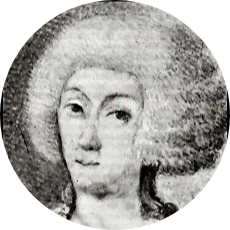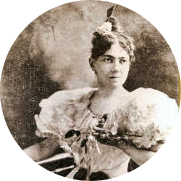Founded in 1893, the Bonny Kate Chapter, NSDAR, was named for Katherine “Bonny Kate” Sherrill Sevier (1754-1836), who was the wife of John Sevier (1745-1815). John Sevier was known for being an American Revolutionary War hero, governor of the State of Franklin, and the first governor of Tennessee.
Legend has it that their courtship began after she was surprised by an Indian attack while milking a cow outside the walls of Fort Watauga in northeast Tennessee. The defenders of the fort quickly closed the gates, locking her out. She ran to the palisades and with the help of John Sevier, climbed to safety. Katherine and John married in 1780 when she was twenty-six, and after the death of his first wife Sarah Hawkins.
Bonny Kate made soldiers uniforms, cast lead balls for ammunition, and prepared food for her husband’s victorious campaign against the British at the Battle of Kings Mountain in South Carolina. On the eve of the battle, she thwarted a Tory attempt to murder her husband.

Bonny Kate and John Sevier had eight children: Catherine, Ruthe, George Washington, Samuel, Polly, Eliza, Joanna, and Robert.
She passed away in 1836 and was originally buried in Russellville, Alabama, but was reinterred in 1922 next to her husband on the lawn of the old Knox County Courthouse in Knoxville.
Bonny Kate, “the brightest star among pioneer women of this state” is engraved on her tombstone.
The Bonny Kate Chapter, NSDAR, was founded by Mary Boyce Temple in Knoxville, Tennessee, in 1893. Mary Boyce Temple was a preservationist and philanthropist in the late 19th and early 20th centuries. In addition to serving as the regent of the chapter for many years, she was also the first president of the Woman’s Club in Knoxville, founded the Ossoli Circle, and served as the first secretary of the General Federated Woman’s Club of Tennessee.

Miss Temple gave a generous donation for Memorial Continental Hall, and she aided Mary Margaretta Fryer Manning (1898-1901), President General, in the selection of the location of Memorial Continental Hall in Washington, D.C. She was present at the laying of the cornerstone and later invested an additional $200,000 bond to complete the building.
During her tenure as regent, the Bonny Kate Chapter, NSDAR, raised significant funds for the DAR Hall for boys at Lincoln Memorial University, established two mountain libraries (one in Unicoi County and the other at Oliver Springs), and contributed funds toward the statues of Andrew Jackson and John Sevier to be placed in Statuary Hall in the National Capitol.
In 1925, Blount Mansion, the birthplace of the state of Tennessee and the home of William Blount, Governor of the Territory South of the River Ohio, was about to be razed for business purposes. This brought prompt action by the Bonny Kate Chapter, NSDAR, and Miss Temple, who was regent at the time, to make plans to save the mansion. Miss Temple gave a personal check of $100 to hold the option. Blount Mansion was pronounced the “most historic spot” in Tennessee, and this check still hangs in the mansion today.
Bonny Kate Chapter, NSDAR, has continued to mark many historic spots, including the Old Chisholm Tavern, the birthplace of Bonny Kate Chapter, NSDAR, and the Henley Street Bridge.
In 2003, the Mary Boyce Temple house, built in 1908 and also known as the Chambliss-Temple house, was threatened by new construction. The Bonny Kate Chapter, NSDAR, worked closely with the mayor of Knoxville, the developer, and countless others to preserve the home and secure the funds needed to ensure its future.
Sources:
Fred W. Sauceman, East Tennessee State University
